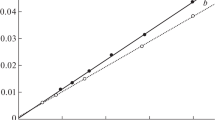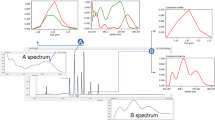Abstract
This paper describes the use of the overlapping resolution mapping procedure to optimize the separation of priority pollutants by isocratic, reversed-phase high-performance liquid chromatography. Three classes of pollutants are considered: polycyclic aromatic hydrocarbons, substituted phenols and phthalate esters. The procedure requires only seven chromatographic runs for each set of pollutants before an optimized mobile phase composition is derived which can satisfactorily resolve all the components in the respective mixtures of pollutants. The main advantage of such a systematic scheme to optimize mobile phase compositions is an improvement in method development times compared to conventional techniques. Another benefit is that expenditures on solvents are reduced.
Similar content being viewed by others
References
Berridge, J. C.: 1985, Techniques for the Automated Optimization of HPLC Separations. John Wiley, Chichester, England, 203 pp.
Glajch, J. L., Kirkland, J. J., Squire, K. M. and Minor, J. M.: 1980, ‘Optimization of Solvent Strength and Selectivity for Reversed-Phase Liquid Chromatography Using an Interactive Mixture-Design Statistical Technique’, J. Chromatogr. 199, 57–79.
Runser, D. J.: 1981, Maintaining and Troubleshooting HPLC Systems: A User's Guide, John Wiley, New York, 163 pp.
Snyder, L. R.: 1974, ‘Classification of the Solvent Properties of Common Liquids’, J. Chromatogr. 92, 223–230.
Snyder, L. R.: 1978, ‘Classification of the Solvent Properties of Common Liquids’, J. Chromatogr. 16, 223–234.
Snyder, L. R. and Kirkland, J. J.: 1979, Introduction to Modern Liquid Chromatography (Second Edition), John Wiley, New York, 863 pp.
van der Wal, Sj.: 1985, ‘Low Viscosity Organic Modifiers in Reversed-Phase High-Performance Liquid Chromatography’, Chromatographia 20, 274–278.
Author information
Authors and Affiliations
Rights and permissions
About this article
Cite this article
Ong, C.P., Khan, M.R., Li, S.F.Y. et al. An optimization procedure for the isocratic high-performance liquid chromatographic separations of environmental pollutants. Environ Monit Assess 19, 35–46 (1991). https://doi.org/10.1007/BF00401295
Issue Date:
DOI: https://doi.org/10.1007/BF00401295




